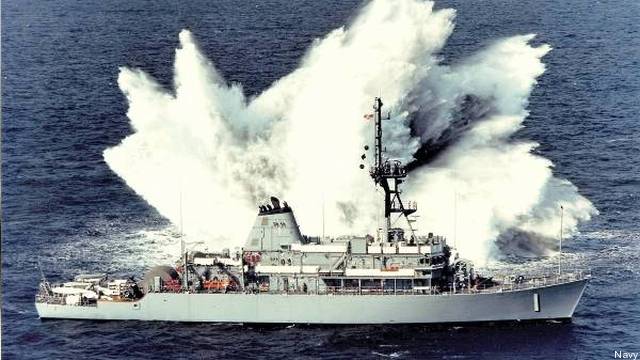‘Deadly Serious’ Navy Wrestles With Mine Warfare Modernization
Posted on
 [updated 12:45 Tuesday with VCNO Burke comment] PANAMA CITY, FLORIDA: Improving the Navy’s long-neglected capability to hunt mines is a top priority for the fleet — but it still gets less than 1 percent of the Navy budget.
[updated 12:45 Tuesday with VCNO Burke comment] PANAMA CITY, FLORIDA: Improving the Navy’s long-neglected capability to hunt mines is a top priority for the fleet — but it still gets less than 1 percent of the Navy budget.
“We do have a sense of urgency and I think we’re applying as much resources as we can,” said Rear Adm. Frank Morneau, deputy director of the Navy’ staff’s Expeditionary Warfare division. Starting at the top with Chief of Naval Operations Jonathan Greenert — who recently dispatched more minesweepers to the Gulf — “senior leadership in the Navy and in the Marine Corps are deadly serious about focusing on this mission and trying to get it right,” despite ever-tightening budgets, Morneau said at the National Defense Industrial Association’s annual Expeditionary Warfare conference here. “I wouldn’t be discouraged just because we’re under fiscal pressure.”
The long-term standard bearer for the Navy mine-warfare force is the Littoral Combat Ship, but the LCS counter-mine “mission package” is still in development, so the existing inventory of MH-53E Sea Dragon helicopters and aging Avenger-class minesweepers must bear the brunt of rising tensions with Iran. “The balance is [that] with a finite amount of resources, we have to take care of the legacy force and get the LCS mission package into the fleet,” said Captain Frank Linkous, the Navy staff’s mine-warfare director under Morneau. Today in the Gulf, said Linkous, “the legacy force [is] at the tip of the spear.”
Morneau, Linkous, and the other Navy officials assembled for Monday afternoon’s panel on mine warfare touted multiple new initiatives on both fronts — but all these efforts have their limits:
Next week, Bahrain-based 5th Fleet is hosting an unprecedentedly large International Mine Counter-Measures Exercise (IMCMEX) with more than 25 nations. The Navy is still working, though, to get its system for sharing mine-threat data, MEDAL (Mine Warfare Environmental Decision Aid Library) to communicate fully with allied forces.
- A type of unmanned submersible called the Mark 18 Swordfish has been deployed to 5th Fleet to help hunt mines. By January, 5th Fleet will also have the SeaFox “neutralizer,” a kind of smart torpedo that destroys mines from a safe distance, which be launched both from small craft called RHIBs (Rigid-Hulled Inflatable Boats) and MH-53 helicopters. Both systems are “showing promise,” said Vice Adm. William “Bill” Burke, the Deputy Chief of Naval Operations, in a conversation with reporters Tuesday, but both systems are so new that it’s in question “when we can get enough assets in theater — some of them are still being built.”
- The existing minesweepers and helicopters are being upgraded with new sonar, and three Avengers are being outfitted with SeaFox. “Those ships in the past have not been well taken care of,” Burke said bluntly, but in the past year, “we have put a ton of money in to fix them.” That said, the Avenger is still an aging platform, approaching thirty years, and even if the hull could last much longer, it lacks the speed and helicopter-carrying capacity of the LCS.
- The LCS mine warfare module is now in testing, with an operational evaluation (OPEVAL) expected in 2014. LCS has had a host of ups and downs, however. Recently the Navy decided the MH-60S Sea Hawk helicopter that LCS carries simply lacks the endurance of the current MH-53s to haul mine-detecting sonar arrays through the water, so it is seeking a new way to “sweep” the water for mines: “We have a sweep system,” said Linkous, “[but currently] it doesn’t have anything to tow it.
- In addition to LCS, the Navy is moving towards a new class of small patrol craft, the Mark 6 Patrol Boat, whose mine-warfare functions will be tested out on an experimental 77-foot “Coastal Command Vessel” early next year. But only six of the patrol boats are currently planned.
- The Navy is also experimenting with using a converted amphibious warfare ship, the USS Ponce, as an “Afloat Forward Staging Base” to support mine-clearing operations. Two dedicated AFSB ships are planned, based on the Mobile Landing Platform (MLP) ship design, but a mine-warfare kit for them is still in development.
All told, Navy minehunters face an uphill battle, while would-be minelayers in Iran and elsewhere can use cheap technology that’s easy to deploy — or you can not deploy it at all: “How many mines does it take to mine a strait?” Morneau asked. “None. You’ve just got to say you did it.” But determining whether the mines are there or not, let alone clearing them, is a tremendous technical challenge.
“Mine warfare is our most complex and challenging mission,” said Capt. John Ailes, the program manager overseeing development of the LCS mine warfare module and other mission packages. Ailes has worked on a range of high-tech programs, including the Aegis system that detects and shoots down attacking planes, he said, “but all those pale in comparison to the complexity of distinguishing a mine against the [underwater] background when it doesn’t put out any signal, it just sits there and waits.”
On the upside, “I have never had this degree of interaction with senior leadership as I do on a routine basis in mine warfare,” said Ailes. “I don’t think there’s a four-star anywhere in the chain that I haven’t met, usually with some degree of emotion” — there was a burst of laughter from the audience — “and I say that as a good thing.”
Subscribe to our newsletter
Promotions, new products and sales. Directly to your inbox.
